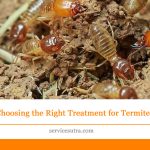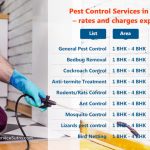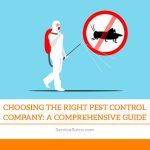Updated: January 21st, 2023
Termites are much more dangerous that other pests and rodents, as it pose serious threat to the structure of the building and deal significant amount of damage to it. Getting rid of termites from your property is not an easy task. Unlike cockroaches, spiders, bedbugs and rodents, these tiny pests might not look scary or significant to the naked eye but, damage done by them will surely bring you to your knees. As getting rid of these pests are much tougher than removing other pests that are mentioned above. This post will give an overview about this unwanted pests and some proven methods to remove them efficiently.

Here’s how to prevent and treat termites at home and garden
Termites can be of different types and depending on the level of termite infestation, termite control companies use different methods and prevention techniques. I will be talking about a few of those techniques, but first lets understand about the origin of termites.
Origin of Termites
Just like other pests and bugs removal techniques, first you need to track down the place of infestation, to locate their hideouts, examine the objects made of wood like cupboard, beds, furniture, doors, pillars, floor beams wooden almirah etc. and in gardens you should look for them on the trunks of trees, any swampy areas. These bugs leave mud trails behind so it is not that hard to find them. As soon as you identify their origin take immediate actions to eradicate them as they are one of the biggest contributors to home destruction.
What attracts termite?
There are three most important factors that draw the attention of termites; they are soil, wood and water.
Soil: This is the favorite habitat for termites; they build underground tunnel systems called galleries. This not only creates a safe hideout for them but also make it easy for them to get food from wood, paper etc. available at your home or garden.
Wood: Wood is a great source of cellulose, and cellulose is the favorite food for termites. The primary source of food for them is vegetation, dung and their favorite is wood of course.
Water: Like all other living beings they cannot survive without water. A leaky faucet or a random stagnant water source, from wherever they get moisture they will be form their nest there.
Various types of termites
They are generally two types of termites that infests at our home or garden, dry wood termites and subterranean termites.
Dry Wood Termites: The dry wood termites do not require soil or mud to survive, these little buggers form their nests in dry and undecayed wood, and they target wooden structures like furniture, doors, cupboards etc. they eat up and eject fine wood dusts from the wooden structures in which they feed & live and slowly destroy them.
Subterranean Termites: These are even worst than the former one as they live in woods and forms a soil layer around it. They create thin tunnels of mud across the areas and eventually do more damage than dry wood termites.
There are separate techniques to remove these tiny agents of destruction.
Apply Orange oil: Orange oil is effective in cleaning various pests by dissolving their exoskeletons and destroying their cell membranes and let them die a painful death. D-Limonene present in this oil is the main ingredient that does the maximum damage.
How to use: Drill fine holes into the infested wooden items and inject the oil into the hollow spaces using a fine dropper where the bugs are residing, it will make their habitat hostile and will soon yield results depending on the extent of infestation, it might take few days or, few weeks too.
Cost: 180 INR (Approx)
The microwave technique: Use of portable microwaves can deal great damage to these insects. If you can accurately detect their exact locations and use it for enough time, then it can exterminate them upto 90% efficiency.
How to use: 10 to 30 minute treatment time would be enough to treat a 1-2 feet of wooden board. You need not drill the board.
Cost: Depends on availability
The electrocution method: Portal electrical devices are available with the help of which you can electrocute these tiny buggers.
How to use: To produce optimum results you can drill the wooden surface a little. And then apply the technique.
Cost: Depends on availability
Using Sunlight:
This is a free of cost technique to remove these insects from the infested areas.
How to use: Simply take the item out and expose it to sunlight, the invaders will die within 2–3 days, as they like darkness and cannot survive under heavy light and heat.
Cost: Free
Subterranean termite control treatments:
Boric acid treatment: It is one of the most common and effective way of dealing with termites and other pests. It is natural insecticide that dismantles them by shutting down their nervous system and by dehydrating them to death.
How to use: Simply spray or coat the wooden surface with it. Place bait stations at your garden / home, fill them regularly with fresh stock, beware that this is a poisonous chemical, make sure that it is out from the reach of your pets and children, as inhaling and ingestion of boric acid can be very harmful. Use gloves and face mask while using it.
Cost: 430 INR (Approx) / oz
The cardboard trap: As mentioned above cellulose is their favorite food which they gather from feeding on wood and paper. Hence you can use the above for driving them towards the trap.
How to use: Take 3-5 sheets of flat cardboard and wet them by applying water. Put the whole setup near the most infested areas. Soon (within 1-2 days) the pests will take the bait and invade it, after they do, put on gloves, take the whole thing out and expose it to sun or burn them down whichever gives you a sense of satisfaction. If there is severe infestation repeat the process until you kill every one of them.
Cost: 9 INR / piece
Few preventions techniques:
Identify and fix all water leaks to avoid stagnant water, which is an ideal place for the termites to live in.
Remove bush and vegetation growth as the presence of these things might encourage moisture that will attract them so disappoint them by making the environment hostile for them to live.
Store excess building materials and firewood away from your home or garden. As these things will attract hungry termites towards them, if possible raise the height of these things off the ground in order to keep them out of reach from the termites
Remove dead trees or roots from your garden as these things will definitely be an open invitation for the termites to come and feed on them.
Don’t ever bury lumber or wood scraps in your garden as it significantly draw the termites towards your place.
Conclusion
Periodically, get your home inspected by professional pest control companies for termite treatments. An annual inspection can save your home with early detection. If termites are not found in your property, the trained pest control experts can offer recommendations to help you prevent a possible termite invasion.






